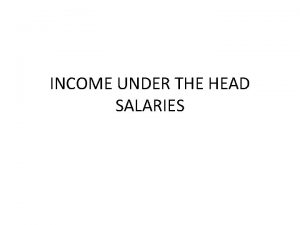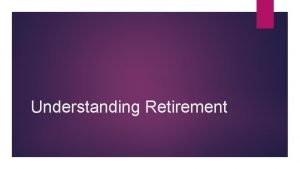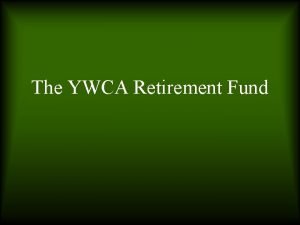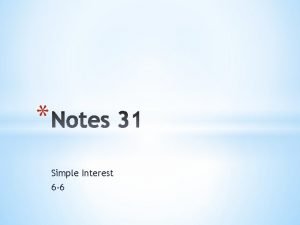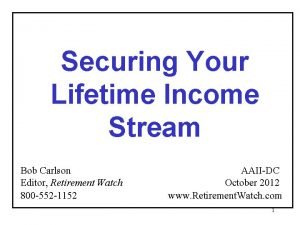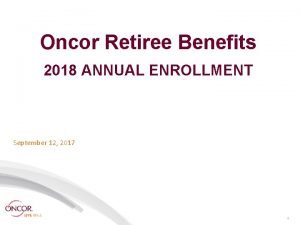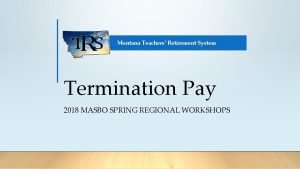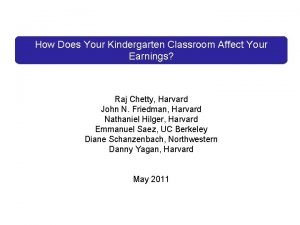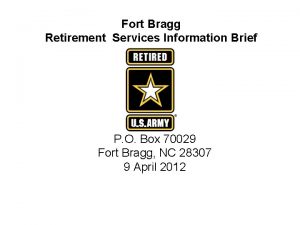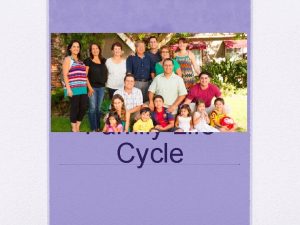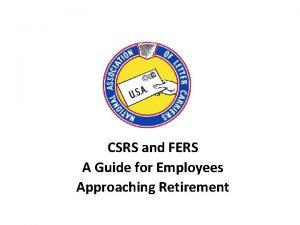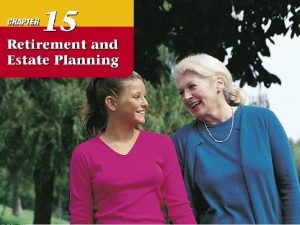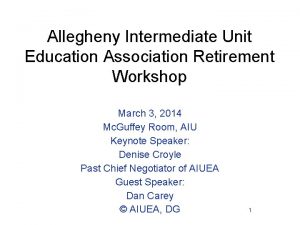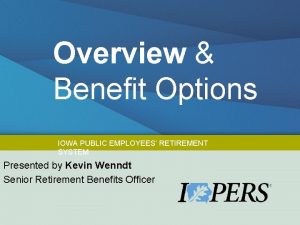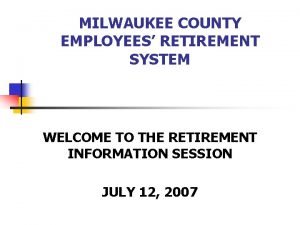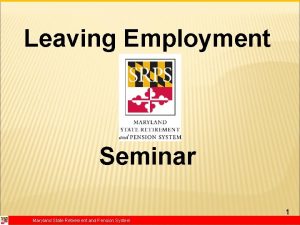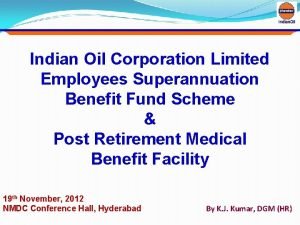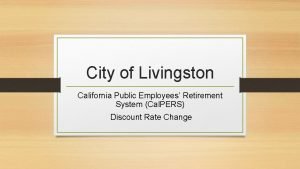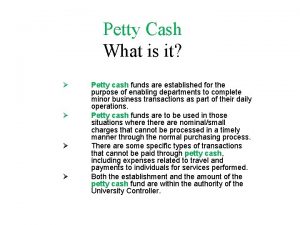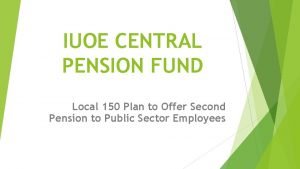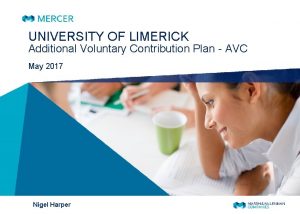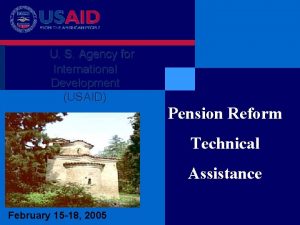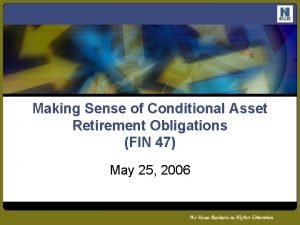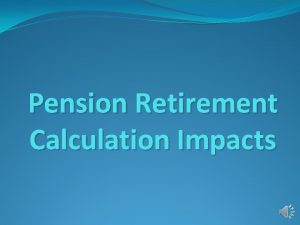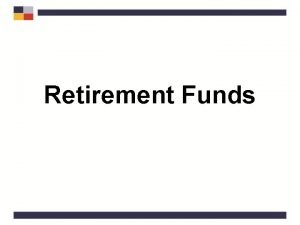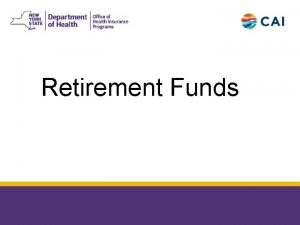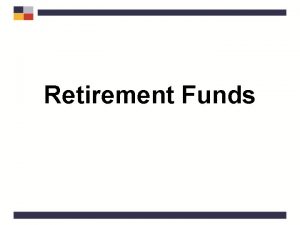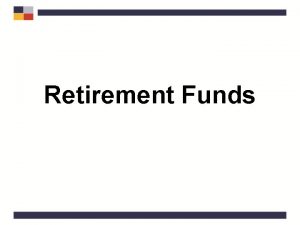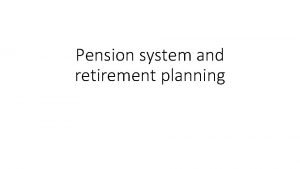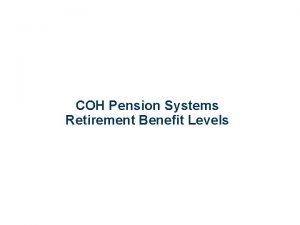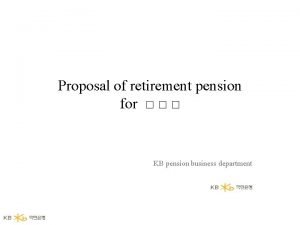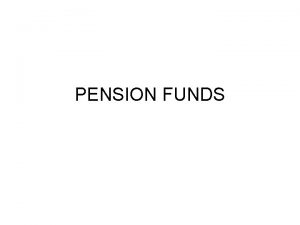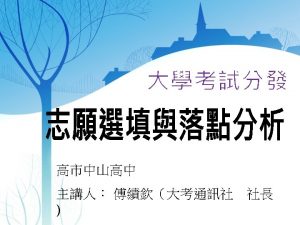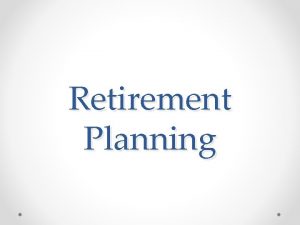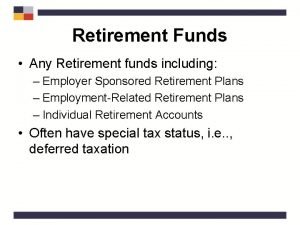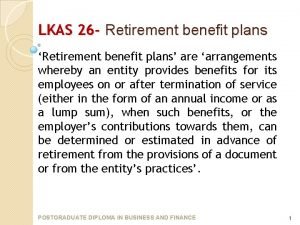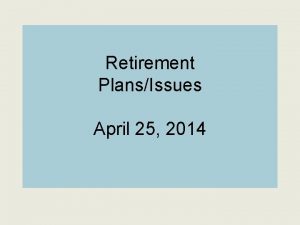Pension 102 Types of pension Types of retirement


















![Death-cum-Retirement-Gratuity (DCRG) : illustrations Formula : [Last Pay(Emolument) + D. A ] X Qualifying Death-cum-Retirement-Gratuity (DCRG) : illustrations Formula : [Last Pay(Emolument) + D. A ] X Qualifying](https://slidetodoc.com/presentation_image_h2/5eb11b3b676ba7ef8fa9a7519e6cbf45/image-19.jpg)














- Slides: 33

Pension 102 • Types of pension • Types of retirement • How are pensionary benefits worked out? Niketan Sahoo, Sr AFA, Pension, Western Railway

Types of pension in IR category of pension Retirement/Exit Clause covered Superannuation Pension Superannuation, Retirement Retiring Pension Voluntary Retirement Compulsory Retirement Premature Retirement Technical Resignation Invalid Pension Medical Invalidation Compensation Pension Abolition of post with loss of earning capacity. Disability Pension Permanent disability (unfit for alternative job/post) Compensatory Allowance Removal from service as a measure of penalty Family Pension 1 Enhanced Family Pension 2 Normal Family Pension Death in Service Missing (whose whereabouts not known) Extra-ordinary pension Death/serious Injury attributed to duty with Lump-sum payment of Ex-gratia. 2

Exit clauses : cessation of railway service 1 Retirement 2 Resignation • Superannuation retirement . Resignation on personal ground • Voluntary retirement . Resignation in public interest (technical resignation) • Compulsory retirement • Pre-mature retirement • Invalid retirement 3 Removal/dismissal 4 Death 5 Disability (attributed to duty) 6 Missing 3

Retirement on superannuation Prescribed age limit for all railway employees : 60 years of age (Do. B+60 years) Prescribed age limit for railway doctors (Medical Service) : 65 years of age If the employee’s Do. B is 1 st of a month, the employee shall retire on last working day of previous month. If the employee’s Do. B is 2 nd or later, the employee shall retire at the end of the employee’s month of birth. Example : i. Do. B : 01 -04 -1960, date of superannuation : 31 -03 -2020 ii. Do. B: 05 -04 -1960 , date of superannuation : 30 -04 -2020 Minimum Qualifying Service (QS) required to be eligible for pension : 10 years If an employee’s QS is less than 10 years but more than 5 years, the employee is due for Service Gratuity in lieu of pension. It is the responsibility of the Administration as well as the employee to ensure that superannuation retirement happens on attaining the prescribed age limit. In case of overstay, any additional payment of pay and allowances shall be recovered from the employee by adjustment with pension amount that becomes due with retrospective effect. 4

Voluntary Retirement (VR) Ground : Personal/medical reason Qualifying Service: Minimum 20 years (completed) Notice Period: Three months advance notice ( notice period may be waived by the Competent Authority on valid and acceptable grounds) DAR/Vigilance clearance : Mandatory Acceptance: Acceptance of VR by the Competent Authority is mandatory Voluntary Retirement may be sought on medical grounds if employee is found medically unfit for railway service VR can not be accepted if employee is on Extraordinary Leave or on Leave without Pay & Allowance. Reemployment : An employee opting for VR is not allowed to take up another government job until expiry of two years after VR. 5

Special VR Sometimes special VR schemes may be introduced by the government with certain incentives for certain categories of staff owing to over staffing/safety/other administrative compulsions. For example : LARSGESS (Liberalized Active Retirement Scheme for Guaranteed Employment for Safety Staff) introduced in 2013. Under LARSGESS, in addition to all pensionary benefits, one of the eligible family members (son/daughter) is provided with a job in Railways. At the same time the retiring employee is entitled to all pensionary and retirement benefits at par with normal retirement cases. 6

Invalidity, Compulsory, Compassionate Retirement on being invalid • Ground : Being found medically unfit by the Medical Board • Assignment of alternate job/post not feasible • Qualifying Service for pension: 10 Years and above • Pensionary Benefits : All benefits allowed at par with normal retirement cases. • Commutation subject to further examination by doctor to decide longevity factor. Compulsory Retirement: • Ground : Punishment/penalty • Qualifying Service for pension: 10 Years and above • Pension: Not less than 2/3 or full pension as decided by the authority. • Commutation subject to further examination by doctor to decide longevity Compassionate Allowance: • Admissibility : In the case of Removal from Service, subject to consideration/sanction by the competent authority considering gravity of the case as well as financial condition of the employee • Pensionary benefits : 2/3 rd of pension or 2/3 rd of gratuity or both as decided by the competent authority subject to minimum Rs. 9000 per month plus relief. 7

Pension benefits on resignation 1 2 Resignation on personal ground: • Forfeiture of service, no pensionary benefits admissible • Leave Encashment up to 50% of Leave (maximum 150 days) allowed Resignation in Public Interest (technical resignation): 1. To take up a job in other government department with prior permission, relieved by the parent organisation through proper channel to report to the new organisation. 2. For permanent absorption in a PSU after completion of deputation period. • Service not forfeited, employee eligible for future benefits. • Employee has to exercise either of the two options: (a) either to get his service counted in new organisation if pension scheme exits there. (b) or avail pensionary benefits for the service rendered in the parent department /organisation. Note: In the case of permanent absorption, Dearness Relief on pension (wherever sanctioned) is regulated as per the fixation of pay in the new organisation. 8

Pension in case of dismissal or removal Dismissal : Leads to complete forfeiture of service, being unbecoming of railwayman. No pensionary benefits allowed Removal : Also leads to forfeiture of service. Competent Authority may sanction Compassionate Allowance considering gravity of misconduct and socioeconomic conditions of the employee on sympathetic grounds 9

Pension in event of death or employee missing Death: • In case of natural death or death in eventuality while in service, pensionary benefits including DCRG, Leave Encashment and Family Pension as admissible are allowed. • In case of death directly/indirectly attributed to duty depending on nature of job, benefits as admissible under Extra. Ordinary Pension Rule along with lump-sum ex-gratia are allowed. However, commutation of family pension is prohibited in this case. Missing: • In case an employee/pensioner’s whereabouts are not known and FIR has been filed with police to that effect, pensionary benefits are allowed with retrospective effect after waiting for a period of six months from the date of FIR. 10

What are pension-cum-retirement benefits made up of? I. Settlement dues 1. DCRG : Death-cum-Retirement Gratuity (including Service Gratuity) 2. Commutation 3. Leave Encashment 4. Central Government Employees Group Insurance Scheme II. Pension • Pension for self • Family Pension (in case of death/missing) • Additional Quantum of Pension (between ages 80 -85 : 20%, 85 -90: 30%, 90 -95: 40%, 95 -100: 50% , 100+: 100%) • Compassionate Allowance (in case of removal from service) III. Additional benefits • Fixed Medical Allowance • Constant Attendant Allowance • Composite and Transfer Grant • RELHS (Railway Employees Liberalised Health Scheme) • CTESE (Cashless Treatment Scheme in Emergency) • Post retirement railway passes 11

Factors regulating pensionary benefits Staff Category: (a) General (b) Running staff (c) Railway Medical Service (d) Teaching Staff Emoluments: (a) Last pay (b) Reckonable emoluments (c) Last 10 months’ average emoluments Qualifying Service: Nature of working post: (a) Permanent (b) Temporary Status (c) Casual Labour (d) Substitute (e) Trainee (f) Probationer Family details: (a) Marital status (b) Dependents’ details (a) Length of total service (b) Non-Qualifying period (c) Added years of service (d) Previous service Conduct : (a) DAR/vigilance cases (b) Penalty/punishment Reason for cessation of service: (a) Retirement (b) Death (c) Disability (d) Technical Resignation (e) Missing (f) Removal (g) Dismissal (h) Resignation. 12

What is considered as Qualifying Service Total Service vs. Net Service : Service rendered by the employees from date of entry to date of retirement/death in service(Total Service) Minus Non-Qualifying period Plus previous Service if any Non-qualifying service: Period spent on leave without pay (other than on Medical ground) Suspension period Period of Extra-ordinary Leave other than granted for Medical/Higher Study Period of Casual Labour before attaining Temporary Status Half of Service rendered as Temporary status First Four months period for Substitutes followed by regularisation Dies-Non period 13

How is qualifying service arrived at? Qualifying Service is always calculated in terms of Half Year periods of service in which: Period of three months and above and less than nine months is treated as six months, eg, 28 Y 7 M 15 D = 28. 5 years Less than three months is rounded off to previous year, eg, 28 Y 2 M 10 D =28 years More than nine months is rounded off to next year, eg, 28 Y 10 M 20 D =29 years • Minimum Qualifying Service for employee’s pension : Ten years and above • Minimum Qualifying Service for Family Pension : Irrespective of Q. S if the post has been regularised. • Maximum Qualifying Service for Pensionary benefits : 33 years (66 half years) as in 35 Y 4 M 05 D =33 years 14

Qualifying service : illustrations Mr X : DOA: 18 -08 -1990, DOR : 30 -06 -2020, LWP: 110 days DOR: DOA: Total Service: Less LWP: Net QS: YYYY-MM-DD 2020 -06 -30 1990 -08 -18 29 Y-08 M-12 D 00 Y-03 M-20 D 29 Y-04 M-22 D i. e. 29. 5 years i. e. 33 Years Mr Y: Casual Labour since 01 -01 -1982; Temporary Status : 01 -10 -1983; Date of Regularisation: 15 -10 -1990; Date of Retirement : 31 -05 -2020 DOR: Date of Regularisation: Total Service: Add 50%of TS period: Net QS: YYYY-MM-DD 2020 -05 -31 1990 -10 -15 29 Y-07 M-16 D 03 Y-06 M-08 D 33 Y-01 M-24 D 15

Emoluments considered for pensionary benefits Emoluments for working out pensionary benefits refer to the Last Pay drawn by the employee plus reckonable allowances as applicable in the case of the employee’s category • Average Emoluments : emoluments drawn in last ten months immediately prior to date of retirement. • Pension : @50% of Last Pay (emoluments) or 50% Average Emoluments whichever is higher. • In case of reduction in Last Pay on account of penalty/demotion, Last Pay becomes less than Average Emoluments. Pension @ 50% of average emoluments being higher, becomes payable. 16

Pension calculation: illustrations General category staff, Mr X, Senior Section Officer, DOR: 31 -01 -2020, last pay: 72, 000 Working : Average emoluments (last 10 months): Last Increment date : 01 -07 -2019 Pension @ 50% of average emoluments of ten months or @50% of Last Pay whichever is higher: Rs. 36000 Last Pay Average Emoluments Higher one Pension 72, 000 71, 250 72, 000 36, 000 17

Pension calculation: illustrations Running Staff, Mr Y, Loco pilot, DOR: 31 -01 -2020, last pay: Rs 60, 000 Railway doctor, Mr Z, Chief Medical Director, DOR: 31 -01 -2020, Last Pay: Rs. 2, 000 18
![DeathcumRetirementGratuity DCRG illustrations Formula Last PayEmolument D A X Qualifying Death-cum-Retirement-Gratuity (DCRG) : illustrations Formula : [Last Pay(Emolument) + D. A ] X Qualifying](https://slidetodoc.com/presentation_image_h2/5eb11b3b676ba7ef8fa9a7519e6cbf45/image-19.jpg)
Death-cum-Retirement-Gratuity (DCRG) : illustrations Formula : [Last Pay(Emolument) + D. A ] X Qualifying Service (maximum 33 years) 2 Maximum limit : Rs. 20, 000 (twenty lakh) Last Pay: 60, 000 DOR: 30 -04 -2020 Q. S: 33 Years DA: @17% DCRG : Basic: 60, 000 + DA: 10, 200 0 (17%) i. e. 70, 200 X 16. 5 =Rs. 11, 58, 300 QS: 33/2 (i. e 16. 5) Note: In the case of Railway Doctor and Running Staff, for the purpose of calculation of DA on emoluments for DCRG, an additional element of 30% is taken into account as also towards Leave Encashment. Example: Running Staff ( Loco Pilot) Last Pay : Rs. 70, 000 DCRG : Basic: 70, 000 + 38, 500 (55 % Running Allown)+ DA: 15, 470 (17% on 70, 000+30%) QS: 33/2 (i. e 16. 5) i. e. 123970 X 16. 5 = Rs. 20 45 505/Max Rs. 20, 000 19

DCRG in the case of death in service To whom Payable: Payable to the Nominee as per nomination made by the deceased railway servant during service. If no nomination exists, payable to family in shares as per Para-71 of Railway Service (Pension) Rule-1993 In case of Minor , payable to wife/husband or through guardian if spouse not alive. 20

Commutation • Commutation is a part of pension that is surrendered and in lieu, a lump-sum payment is received on exercise of option by the employee at the time of retirement. • Maximum permissible limit that a pensioner can commute : @40% of basic pension. • Lump sum value of commutation is worked out with reference to Commutation Table containing purchase value of Re. 1 (based Commutation Table) multiplied by age factor(age on next birth day) for 12 years period. • Example : Say basic pension is Rs. 40, 000 on date of retirement: 30 -06 -2020 (superannuation) Commutation Value : 40% of Rs 40, 000 X 8. 194 (age factor of 61 years of age X 12 i. e. 16000 X 8. 194 X 12 : Rs 15, 73, 248. • Pension is reduced by 40% (to extent of fraction commuted) and pensioner is paid residual pension Say Basic Pension is 40, 000. After commutation of Rs 16000, Residual Pension will be Rs 24000 • Dearness Relief is paid on Basic Pension (ie, full pension before commutation). 21

Commutation : a few facts • Commutation is restored after 15 years from the date of lump-sum payment. • Commutation becomes absolute • without Medical examination: • Superannuation, • Voluntary Retirement (within 1 year of Retirement) or • with Medical Examination : • Compulsory Retirement • Invalidity Retirement • Compassionate Allowance 22

Pros and cons of commutation Pros: Cons: • Take home pension reduced to extent commuted • Meets immediate Financial needs • Fetches better capital gains if invested wisely • Lump-sum value calculated for 12 years but recovery made for 15 years • Careless investment/spending leads to long-term financial crises • Non-reduction of commutation by banks leads to over-payment of pension • Income Liability on pension is reduced • Dearness Relief is paid on basic pension in spite of fraction commuted and increases undue burden on Railway. • Pension once commuted cannot be reversed. • Note: Commutation is not allowed in case of Provisional Pension sanctioned during pending of DAR/vigilance cases • Recovery is waived of in case of death (not recovered from family) • Family Pensioner does not have right to opt for commutation 23

Leave encashment Maximum Earned Leave allowed for encashment : 300 days Payable @ : (Basic Pay + DA) X Number of days of Leave (maximum 300 days) 30 Example: If Leave Balance : 300 days (50, 000 +8500)/30 X 300 = Rs. 5, 85, 0000 Any shortfall in Leave balance (LAP) from 300 days , can be made good with HLAP but at half Rate: Say Mr X has 285 days LAP and 110 days HLAP (15 days HLAP can be adjusted for encashment) Leave Encashment (in case of adjusted Leave) : (i) (50000 + 8500) /30 X 285 : 555750 (based on LAP) (ii) (50000 +8500) /30 X 15/2 : 14624 (based on HLAP) Amount of Leave encashment (i)+(ii): 570375 (555750 + 14624) Note : In case of Resignation, Leave Encashment to the extent of 50% of Leave available as balance (sub to max 150 days) is allowed. 24

Eligible member(s) covered under definition of family for pension benefits’ entitlement § Wife or Wives including judicially separated wife. § Husband in the case of female employee. § Unmarried and unemployed son below 25 years of age. § Unmarried and unemployed daughter below 25 years of age. § Dependent and unmarried /widow /divorced daughter above 25 years of age. § Physically disabled /mentally retarded son/daughter irrespective of age. § Dependent disabled sibling. § Dependent parents (mother first)—if not survived by spouse/children. Note 1: Son/daughter will include step sons/step daughters Note 2: Judicially separated wife, ie, both spouses live separately under law but marital status remains intact, will fall under definition of Family whereas in case of Divorce, the marital status ceases to exist. After Divorce, wife will be excluded from Family with no rights on employee’s pension. 25

Who is eligible for family pension? Category I : Covers those who have an immediate and prior claim for family pension in the event of death of railway employee/pensioner. These are: • Wife/Wives • Husband • Dependent Son/daughter below 25 years of age • Physically disabled or mentally retarded son/daughter/sibling Category II : Covers those whose claim is secondary to member(s) listed under category I. These are: • Unmarried/widowed/divorced daughter above 25 years of age. • Dependent parents 26

Dependency criteria for family members (other than for spouse) Marriage: v Son: unmarried and unemployed v Daughter: unmarried/widowed/divorced and unemployed Exemption from marriage clause: Son/daughter /sibling suffering from physical/mental disability Income: Income from any source should not exceed more than Minimum Pension amount plus Dearness Relief v (Presently Rs. 9000/- Plus Relief) Note: Dependency criterion must be fulfilled during the lifetime of the pensioner/spouse 27

Additional conditions concerning Family Pension Split Pension : This means Family Pension payable in equal shares in case if • Employee is survived by more than one legally wedded wife • Employee has left behind wife and eligible child from pre-deceased wife • Employee has left behind eligible son/daughter from both deceased wives Definition of Family, expanded clause : • Post retirement spouse/child (children) • Children born out of illicit (live-in) relationship • Legally adopted son/daughter (adopted through legal adoption deed) • Employee survived by dependent parents but no spouse/children; Mother first claimant when both parents are alive Note: It is obligatory on the part of an employee to make Declaration of Family with their status during his/her service period as well as post-retirement. 28

Rates for calculating family pension Enhanced Family Pension: Rate: @50% of Last Pay(emoluments) but not exceeding pension amount due had the pensioner/employee been alive. Qualifying Service: Seven years or more (else payable at normal rate) Duration (payable up to): (i) In case of death while in Service (employee) : Ten years from the date of death but not beyond ineligibility date of Family member (ii) In case of post retirement death (of pensioner) : Seven years from date of death/date of attaining 67 years of age by pensioner had he been alive Normal Family Pension: Rate : @30% of last pay (emoluments) drawn 1. In case of spouse : payable till date of death/remarriage, whichever is earlier. 2. In case of dependent family member (other than spouse) : payable till attaining age of ineligibility/marriage/employment/ death whichever is earlier Subject to Minimum @ Rs. 9000 plus Relief 29

Family pension calculation ; illustrations Example 1 : Mr X, AME, Last Pay Rs 90, 000, died on 15 -03 -2016 while in service. His date of birth: 10 -05 -1962 and date of appointment : 01 -01 -1985; Qualifying Service: 30 years Example 2 : Mr Y, Ex XEN, Last Pay Rs. 90, 000, retired on 31 -03 -2016, died on 20 -04 -2020 after taking pension for about four years. Date of birth: 10 -05 -1956, date of appointment : 01 -01 -1980, Qualifying Service: 33 years 30

Family pension calculation : illustration contd… Example 3 : Mr Z, Ex Loco Pilot, Last Pay Rs. 60, 000, retired on 31 -03 -2016, died subsequently on 10 -01 -2024 after taking pension for about 8 years. Date of birth: 10 -05 -1956 , date of appointment : 01 -01 -1980, Qualifying Service: 33 years Note : Enhanced FP is not applicable in example 3 on account of application of condition of cut-off date of 67 years of age concerning the pensioner or seven years from date of death whichever is earlier. 31

Recoveries and deductions from settlement dues (DCRG/Leave Encashment) A. Railway dues • RELHS subscription • Recovery relating to railway accommodation (rent, electricity, water, etc) • Overpayment of Pay & Allowances, Bonus, etcetera • Recovery towards Laptop/CUG/Telephone • Recovery of Advances, eg, HBA/MCA/Computer Advance • Amount to be retained as Deposit, if any, towards unforeseen railway claims. • Loss occurred to Railway on account of negligence on part of the employee. Note : Recovery of Railway dues can be made without consent of the employee. B. Non-Railway dues • Loans granted by railway co-operative societies • Recovery on account of implementation of Court proceedings Note : For recovery/deduction of non-railway dues, employee’s consent will be necessary General : No deduction is permissible from lump-sum commutation 32

Thank you 33
 Commuted pension vs uncommuted pension
Commuted pension vs uncommuted pension Retirement agenda
Retirement agenda Ywca retirement fund
Ywca retirement fund William shakespeare 1564 to 1616
William shakespeare 1564 to 1616 State of alaska retirement
State of alaska retirement Simple interest vocabulary
Simple interest vocabulary Bob carlson retirement watch
Bob carlson retirement watch Oncorretirees
Oncorretirees Masbo montana
Masbo montana Momiji health care society
Momiji health care society Retirement savings percentile
Retirement savings percentile Retirement services fort bragg
Retirement services fort bragg Parenting/expanding stage
Parenting/expanding stage Region 10 rams 457 plan
Region 10 rams 457 plan Retirement age born 1967
Retirement age born 1967 Chapter 15 retirement and estate planning
Chapter 15 retirement and estate planning Psea retirement workshops
Psea retirement workshops Caltech retiree benefits
Caltech retiree benefits Wv peia retirement
Wv peia retirement Pers police
Pers police Ucf retirement plan
Ucf retirement plan Ipers retirement options
Ipers retirement options Milwaukee county employees
Milwaukee county employees Md state retirement
Md state retirement Post retirement medical scheme of indian oil
Post retirement medical scheme of indian oil Livingston federal employee retirement planning
Livingston federal employee retirement planning Prudential retirement app
Prudential retirement app Petty cash retirement
Petty cash retirement Cash
Cash Iuoe central pension fund
Iuoe central pension fund Retirement plan limerick
Retirement plan limerick Usaid
Usaid Retirement planning warsaw
Retirement planning warsaw Fin 47
Fin 47
